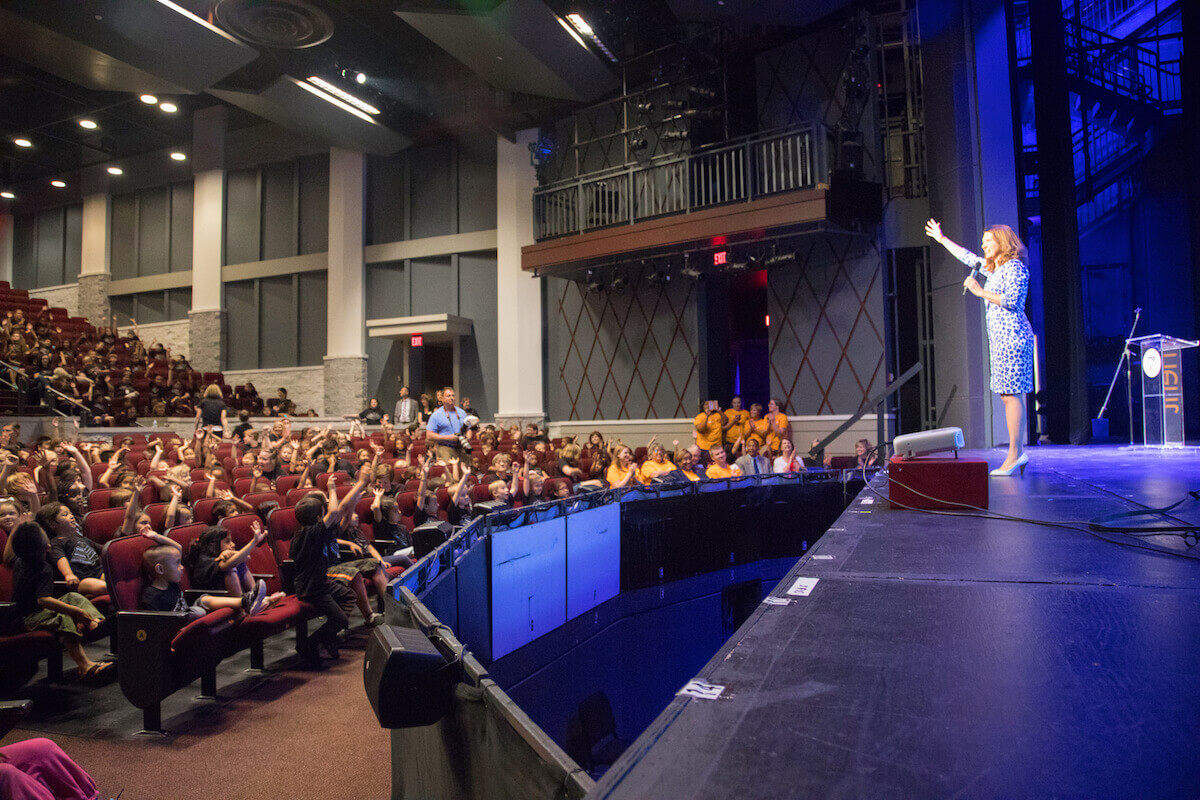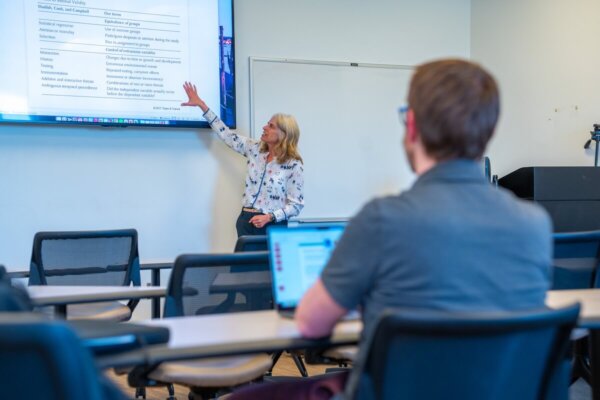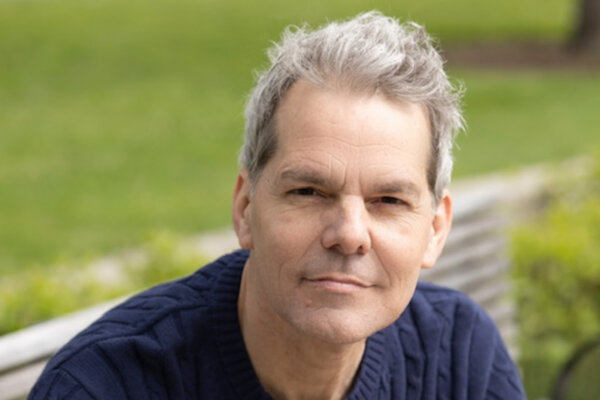An Incubator for Literacy Education
Degree, Conference, Writing Project and Student Writing Effort Combine To Create a Culture of Literacy Education In Northern Virginia at Shenandoah University

For a few special moments on the afternoon of May 31, the entire student body of Winchester’s Garland R. Quarles Elementary School (GQES) celebrated inside Shenandoah’s Ohrstrom-Bryant Theatre (OBT).
The pre-kindergarteners through fourth graders (and their teachers and principal) danced among the theatre’s 600 seats to Pharrell Williams’ “Happy” and Bruno Mars’ “Uptown Funk” to mark an accomplishment that each student could claim: all were newly published authors.
Every one of the school’s individual classes produced a book, each published by Amazon. The online company also donated funds for the publishing lab at the city elementary school, and at the event, its Amazon Web Services division donated $10,000 to the school’s STEM (Science, Technology, Engineering & Mathematics) lab as well.
Mary Tedrow ’99, who is the director of the Shenandoah-based Shenandoah Valley Writing Project (SVWP), and teaches in the Master of Science in Literacy Education (MSLE) program offered by the university’s School of Education & Leadership, was at Quarles for the entire day, which was devoted to celebrating the student-created work, and traveled with the group to OBT. “I almost cried three times,” she said, because she was so moved by seeing children so excited about books.
The accomplishment also impressed Shenandoah University President Tracy Fitzsimmons, Ph.D., who addressed the children in both Spanish and English. “I’m so excited to have you here,” she told the children, who she said can all note that they’re published authors on the college applications they’ll complete in the future.
 The Anchor: Shenandoah University’s Annual Children’s Literature Conference
The Anchor: Shenandoah University’s Annual Children’s Literature Conference
These nascent writing careers are being nurtured by a well-established and growing culture of literacy education at Shenandoah University. Joanie Hovatter ’94, a student in Shenandoah’s Doctor of Education in Administrative Leadership program, has set a goal of having 80 percent of Quarles’ teachers trained through the SVWP, at which teacher leaders train educators to become teacher consultants who return to their schools to promote writing across the preK-12 curriculum.
There are also SVWP-trained educators who are now earning master’s degrees in Shenandoah’s MSLE program, and both the SVWP and the MSLE program are connected to the university’s annual Children’s Literature Conference (CLC), where nationally known authors and illustrators share their stories and process, and educators and librarians delve deeply into literacy issues while earning college credits. The CLC, now in its 33rd year, and literacy activities through Shenandoah are supported, in part, by the Claude Moore Charitable Foundation.
Also, over the summer, MSLE students have the opportunity to assist struggling readers in the Winchester City School system’s “Camp Read-A-Lot,” which meets at Quarles and approaches literacy and reading with methods so fun that Shenandoah Professor of Education, Director of Children’s Literature Program, and Professor of Curriculum and Instruction Karen Huff, Ed.D., said that even the bus drivers taking the children to the program join in on the singsong chant, “We are readers!”
The Degree: Shenandoah’s Master of Science In Literacy Education (MSLE)
Every concentration in the 30-credit MSLE program (early literacy; reading specialist; reading, non-licensure; writing, and individualized design) requires attendance at the CLC, which, this year, features Newbery Medal winners like Lois Lowry (“The Giver”) and Matt De La Pena (“Last Stop on Market Street). In essence, the MSLE program has built upon the successes of the SVWP and works to make teachers better diagnosticians, Tedrow said. “It’s been an exciting and kind of dynamic program,” added Dr. Huff.
“I have learned many strategies for teaching reading and writing from instructors in the program and other teachers in my classes,” said Star Friend ’00, an English and creative writing teacher at Winchester’s John Handley High School, who went through the SVWP in 2017 and is studying in the MSLE program (writing concentration). “I’ve gotten a lot of good ideas for writing prompts and gained an understanding of how collaboration works in teaching writing, as well as more perspective on how it feels to be a student in the digital age. There’s always a new app or program to be learned.”
Friend also noted that the CLC is an inspiring event that many teachers and librarians look forward to attending. “I really enjoy hearing the authors talk about their writing process, their publishing stories, and I like finding new books to use in class and at home with my own kids.”
Quarles third-grade language arts and social studies teacher Alexandra Luden ’19, a student in the MLSE (reading specialist) program, said the books and stories behind them provided through the CLC are invaluable to her as an educator. “Using authentic literature is the basis of my language arts program. Seeing these authors give their stories and share their books give lots of great ideas of how to connect them together,” she said.
The Exploration: Shenandoah Valley Writing Project & Project Write
The SVWP Summer Institute, which runs for four weeks, incorporates the CLC into its experience, with teacher consultants in training spending the early parts of their days at the CLC author/illustrator presentations, and working on their own writing during the afternoons, said Mary Bowser, Ed.D., director of professional licensure and professor of curriculum and instruction in Shenandoah’s School of Education & Leadership. The SVWP also offers a year-round program.
Shenandoah is the only private university in the state to be a writing project site (the SVWP is part of the National Writing Project), Dr. Bowser added. “We are unique,” and she said people call from all over the state asking, “Can I be a part of it?”
SVWP-trained teacher consultants also teach at Project Write, a nonprofit organization that helps students in grades four through 12 develop their written voices and expand their creative thinking. Project Write’s summer session meets during the CLC week, and several authors from the conference meet with the young writers of Project Write. It also provides teacher consultants with the opportunity to watch a variety of students learn and write.
In the fall of 2018, Project Write is partnering with the Alamo Drafthouse Cinema in Winchester for a conference in which students will learn about screenwriting from a professional screenwriter, said Tedrow, who also hopes teachers will attend to learn more about screenwriting, as well.
The Results: Students As Writers
All of these literacy education efforts are making a difference.
“At GQES, especially and within the nearby districts, Shenandoah University’s Children’s Literature Conference, the Shenandoah Valley Writing Project, and Shenandoah University’s Master of Science in Literacy Education program have had a significant impact on our students’ literacy acquisition because of the transformative, positive and professional leadership from the investment of teachers in these programs,” Hovatter said. “Our teachers learn how to help children discover their voice by making meaning as they write because our teachers are writers, researchers, and learners themselves in the Writing Project. Moreover, our teachers learn how to share the lasting gift of loving to read with students as they work to discover just the right books or texts for children’s interests, needs, and goals. At GQES, our teachers collaborate, create, and celebrate with each other and with our students in a thriving literacy community.”
All of these projects: the CLC, the SVWP, the MLSE program, and Project Write, all have one literacy focus. “The student really is in the center,” Bowser said. Through the SVWP, teacher consultants are produced who are more confident in their own writing and pass that knowledge and confidence on to fellow educators and students. Project Write encourages student writing. The MLSE programs and the CLC provide abundant resources to educators to encourage children to write.
Ultimately, it’s all about helping children realize that expressing their voice is important, Bowser said. “That is where we’re really trying to go,” in teaching literacy, she said. Children are more inspired to write when they connect with children’s literature written in authentic voices.
Not much could be more authentic than producing books in a school with its own publishing lab.
It might even be so exciting that students take time out to celebrate the publication of their books with a visit to a university where literacy education is so deeply valued that it offers a master’s program in it, that encourages teachers to explore and improve their own writing, and brings some of the world’s best children’s authors and illustrators to its campus each summer.





